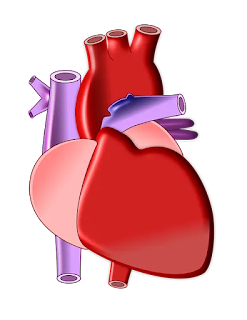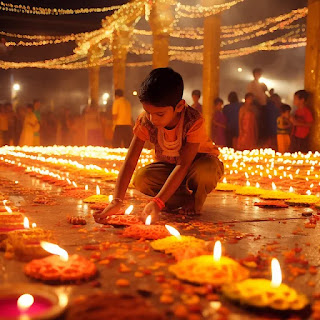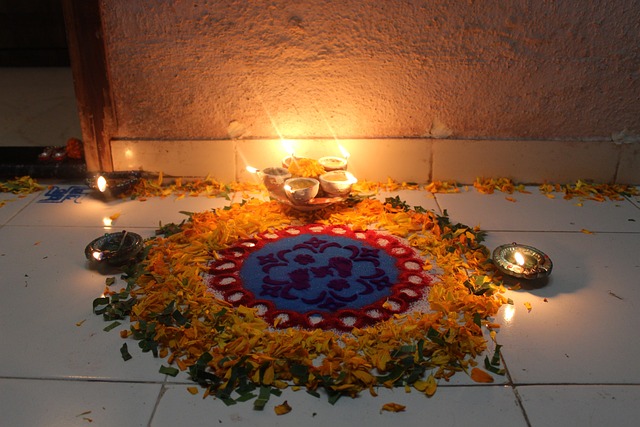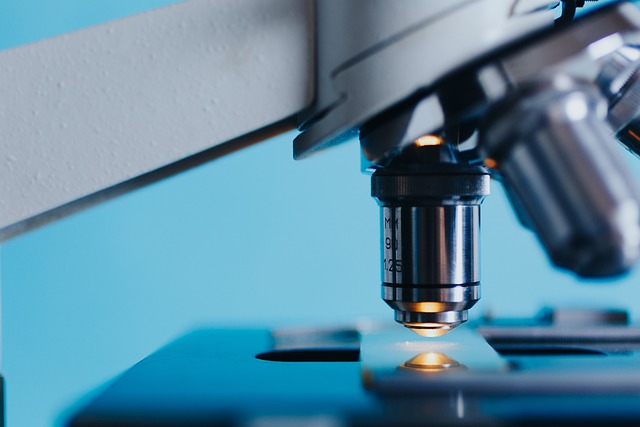Saturday, November 2, 2024
What is Ramayana?
What is Ramayana?
The Ramayana is one of the two great epic poems of India, the other being the Mahabharata. It is a Sanskrit epic attributed to the sage Valmiki and is considered one of the oldest surviving pieces of literature in the world.
Thursday, October 31, 2024
Diwali 2024
Diwali 2024
Diwali, also known as Deepavali, is a major festival celebrated by Hindus, Jains, Sikhs, and some Buddhists. It is a festival of lights that symbolizes the spiritual victory of light over darkness, good over evil, and knowledge over ignorance. The name "Diwali" is derived from the Sanskrit term "dipavali," meaning "row of lights."
Diwali is celebrated during the Hindu lunisolar months of Ashvin (according to the amanta tradition) and Kartika, which typically falls between mid-September and mid-November. The celebrations generally last for five days, with each day holding its own significance and rituals.
The festival is marked by various traditions, including the lighting of diyas (clay lamps), candles, and lanterns to illuminate homes, temples, and workplaces. People also decorate their homes with colorful rangoli patterns, exchange gifts, share sweets, and burst firecrackers.
Diwali holds different religious and mythological significance for different communities. For Hindus, it is associated with the return of Lord Rama, his wife Sita, and brother Lakshmana to Ayodhya after defeating the demon king Ravana. For Jains, it commemorates the attainment of moksha (liberation) by Mahavira. Sikhs celebrate Bandi Chhor Divas, marking the release of Guru Hargobind from a Mughal prison. Newar Buddhists worship Lakshmi on Diwali, while Hindus in Eastern India and Bangladesh worship the goddess Kali.
Diwali is a time for families and communities to come together, pray, and celebrate the triumph of good over evil. It is a festival that embodies the spirit of joy, hope, and renewal.
The word "Diwali" is derived from the Sanskrit term "Dipavali," which translates to "row of lights." It's a compound word:
- Dipa: Meaning "lamp, light, lantern, candle, that which glows, shines, illuminates or knowledge."
- Avalī: Meaning "a row, range, continuous line, series."
Therefore, Diwali essentially signifies a series of lights, symbolizing the victory of light over darkness, knowledge over ignorance, and good over evil.
Diwali, the grand festival of lights, is celebrated annually on the 15th day of the Kartik month in the Hindu lunisolar calendar. This typically falls between mid-October and mid-November. However, the exact date can vary from year to year due to the lunar cycle.
It's important to note that the specific date and day of Diwali can differ slightly based on regional customs and traditions. For instance, in some parts of India, the celebrations might extend over five days, beginning with Dhanteras and concluding with Bhai Dooj.
To determine the precise date of Diwali in any given year, it's advisable to consult a Hindu calendar or a reliable online resource that provides accurate information about the Hindu lunar calendar and its festivals.
The exact origins of Diwali are shrouded in the mists of time, but it's clear that it's a festival with deep roots in ancient Indian culture. While it's celebrated by Hindus, Jains, Sikhs, and some Buddhists, the specific stories and traditions associated with Diwali vary across different communities.
Hindu Traditions:
- Ramayana: One of the most popular legends connects Diwali to the Hindu epic Ramayana. It commemorates the triumphant return of Lord Rama, along with his wife Sita and brother Lakshmana, to Ayodhya after defeating the demon king Ravana. The people of Ayodhya lit diyas to illuminate their homes and welcome their beloved king, marking the victory of good over evil.
- Krishna and Narakasura: Another significant story associates Diwali with Lord Krishna's victory over the demon king Narakasura. It's believed that Krishna defeated Narakasura on this day, freeing 16,000 women who were held captive. This event is celebrated as a triumph of righteousness and the liberation of the oppressed.
Jain Traditions:
- Mahavira's Nirvana: For Jains, Diwali marks the attainment of Moksha (spiritual liberation) by Mahavira, the last of the 24 Tirthankaras. This event is considered a significant milestone in Jain history and is celebrated with great reverence.
Sikh Traditions:
- Release of Guru Hargobind: Sikhs celebrate Diwali as Bandi Chhor Divas, commemorating the release of the sixth Guru, Guru Hargobind, from Gwalior Fort by the Mughal Emperor Jahangir. This event symbolizes the triumph of justice and the protection of religious freedom.
Other Traditions:
- Goddess Lakshmi: Diwali is also associated with the worship of Goddess Lakshmi, the goddess of wealth and prosperity. People offer prayers to Lakshmi, seeking blessings for abundance and good fortune.
- Harvest Festival: In some regions, Diwali is seen as a harvest festival, celebrating the bountiful harvest and thanking the gods for their blessings.
Regardless of the specific tradition, Diwali is a festival that embodies the universal themes of light overcoming darkness, good triumphing over evil, and knowledge prevailing over ignorance. It's a time for joy, celebration, and spiritual renewal, bringing people together to share in the festivities and strengthen their bonds with family and community.
Diwali, the festival of lights, is a vibrant and joyous occasion celebrated with great enthusiasm across India and by the Indian diaspora worldwide. The festivities typically span over five days, each day holding its own significance and unique traditions.
Preparations:
The preparations for Diwali begin weeks in advance. Homes are meticulously cleaned and decorated with intricate rangoli patterns created using colored powders or rice flour. Diyas, small clay lamps filled with oil, are lit to illuminate homes, temples, and public spaces.
Dhanteras:
The first day of Diwali, Dhanteras, is dedicated to the worship of wealth and prosperity. People purchase gold, silver, or other precious metals, believing it to bring good luck.
Choti Diwali:
The second day, Choti Diwali, is marked by the worship of Lord Yama, the god of death. People offer prayers to Yama, seeking protection from untimely death.
Diwali:
The main day of Diwali, also known as Deepavali, is the most significant day of the festival. Homes are brightly lit with diyas, candles, and electric lights. Families gather to perform Lakshmi Puja, a special prayer to Goddess Lakshmi, the goddess of wealth and prosperity. Offerings are made to Lakshmi and Lord Ganesha, the remover of obstacles. The night sky is illuminated with colorful fireworks, adding to the festive atmosphere.
Govardhan Puja:
On the fourth day, Govardhan Puja is celebrated, commemorating Lord Krishna's lifting of the Govardhan Hill to protect the people of Vrindavan from torrential rains. People make offerings to Lord Krishna and decorate their homes with cow dung patties.
Bhai Dooj:
The final day of Diwali, Bhai Dooj, is dedicated to the bond between siblings. Sisters apply a tilak on their brothers' foreheads and pray for their well-being. In return, brothers gift their sisters with sweets and presents.
Other Celebrations:
- Fireworks: Diwali is synonymous with dazzling fireworks displays. People gather in open spaces to watch the colorful explosions of light and sound.
- Feasting and Sharing: Families and friends gather to enjoy delicious feasts, sharing sweets, snacks, and traditional delicacies.
- New Clothes: People often purchase new clothes to wear during Diwali, symbolizing a fresh start and prosperity.
- Gift-Giving: Exchanging gifts is a popular tradition during Diwali. People give gifts to loved ones, expressing their affection and best wishes.
- Community Celebrations: Many communities organize cultural programs, dance performances, and musical concerts to celebrate Diwali.
Diwali is a time for joy, togetherness, and spiritual renewal. It's a festival that brings people together, fostering a sense of community and harmony.
Sunday, October 27, 2024
What is atherosclerosis?
What is atherosclerosis?
Atherosclerosis is a chronic disease characterized by the buildup of plaque within the artery walls.
The Silent Progression
Atherosclerosis is often a silent disease, progressing slowly over many years without causing noticeable symptoms. This insidious nature makes it particularly dangerous, as complications can arise suddenly and unexpectedly.
The Harmful Effects
The narrowing of arteries due to plaque buildup can lead to a variety of serious health problems:
Heart Disease: Atherosclerosis in the coronary arteries can lead to coronary artery disease, which can cause angina (chest pain), heart attack, and heart failure.
Stroke: Atherosclerosis in the carotid arteries, which supply blood to the brain, can increase the risk of stroke.
Peripheral Artery Disease (PAD): Atherosclerosis in the arteries of the legs can lead to PAD, causing pain, numbness, and weakness in the legs.
Aneurysm: Atherosclerosis can weaken the arterial wall, leading to the formation of a bulge called an aneurysm. If an aneurysm ruptures, it can be life-threatening.
Risk Factors and Prevention
Several risk factors contribute to the development of atherosclerosis, including:
- High cholesterol levels
- High blood pressure
- Smoking
- Diabetes
- Family history of heart disease
- Obesity
- Physical inactivity
- Poor diet
To reduce the risk of atherosclerosis and its complications, it's essential to adopt a heart-healthy lifestyle. This includes:
- Eating a balanced diet low in saturated and trans fats
- Regular physical activity
- Maintaining a healthy weight
- Quitting smoking
- Managing high blood pressure and cholesterol levels
- Regular medical check-ups
By understanding the causes, risks, and consequences of atherosclerosis, individuals can take proactive steps to protect their cardiovascular health and prevent this silent threat.
What is a heart attack?
What is a heart attack?
A heart attack, medically termed a myocardial infarction, is a serious medical condition that occurs when the blood supply to the heart muscle is suddenly blocked.
The primary culprit behind a heart attack is often atherosclerosis, a condition characterized by the buildup of plaque within the coronary arteries. Plaque is a substance composed of cholesterol, fatty substances, cellular waste products, calcium, and fibrin. Over time, this plaque can narrow the arteries, reducing blood flow to the heart muscle.
When a plaque ruptures, a blood clot can form at the site of the rupture, further obstructing blood flow. This sudden blockage deprives a portion of the heart muscle of oxygen and nutrients, causing it to die.
The symptoms of a heart attack can vary widely among individuals, but common signs include:
- Chest pain or discomfort: This is often described as a squeezing, pressure, fullness, or tightness in the center of the chest.
- Shortness of breath
- Pain or discomfort in other areas of the upper body, such as the arms, back, neck, jaw, or stomach
- Cold sweat
- Nausea or vomiting
- Lightheadedness or dizziness
- Fatigue
- Weakness
It's crucial to recognize the signs of a heart attack and seek immediate medical attention. Prompt treatment, such as medication to dissolve the clot or a procedure to open the blocked artery, can significantly reduce heart damage and improve the chances of survival.
Prevention of heart attacks involves adopting a heart-healthy lifestyle, including a balanced diet, regular exercise, and avoiding smoking. Managing risk factors like high blood pressure, high cholesterol, and diabetes is also essential.
Saturday, October 26, 2024
Which countries have no snakes at all?
Which countries have no snakes at all?
While snakes are abundant in many parts of the world, there are a few places where these legless reptiles are entirely absent. The primary reason for this is geographic isolation.
Island Nations:
- New Zealand: This island nation, isolated for millions of years, has never had snakes. Its unique ecosystem, free from these predators, has allowed for the evolution of diverse and unique flora and fauna.
- Iceland: Another island nation, Iceland's cold climate and volcanic landscape are not conducive to snake survival. The lack of suitable habitats and prey has kept snakes away.
Extreme Climates:
- Arctic Regions: Countries like Iceland, Greenland, and parts of Canada and Russia have extremely cold climates that are unsuitable for snakes. The harsh winter conditions and frozen landscapes make it impossible for snakes to survive.
- Antarctica: As the coldest continent, Antarctica is entirely devoid of snakes. The extreme cold and lack of suitable habitats make it an inhospitable environment for these reptiles.
It's important to note that while these regions are currently snake-free, human activities and accidental introductions can potentially change this. However, for now, these places remain unique in their absence of these slithering creatures.
Related Content: Is it normal for a snake to feel cold when picked up?
Is it normal for a snake to feel cold when picked up?
Is it normal for a snake to feel cold when picked up?
Snakes, like many other reptiles, are ectothermic creatures, often referred to as "cold-blooded." This means they rely on external heat sources to regulate their body temperature. Unlike endothermic animals (like mammals and birds), which generate their own body heat, snakes absorb heat from their surroundings.
When a snake is picked up, it's likely that its body temperature is lower than your own, especially if it hasn't been basking in the sun recently. This temperature difference makes the snake feel cold to your touch.
To maintain their optimal body temperature, snakes often engage in behaviors like basking in the sun or seeking out warm surfaces. This allows them to absorb heat and regulate their metabolism.
So, the next time you handle a snake, remember that its body temperature is directly influenced by its environment. While it may feel cool to you, it's perfectly normal for a snake to have a lower body temperature.
Related Content: Which countries have no snakes at all?




































































